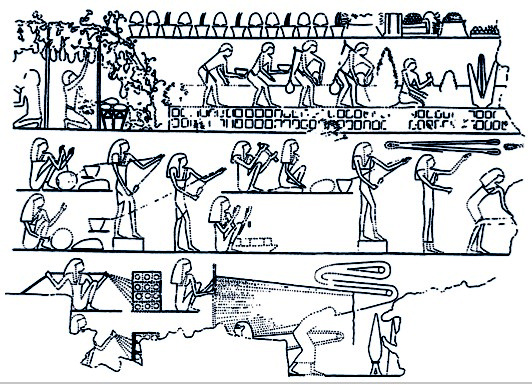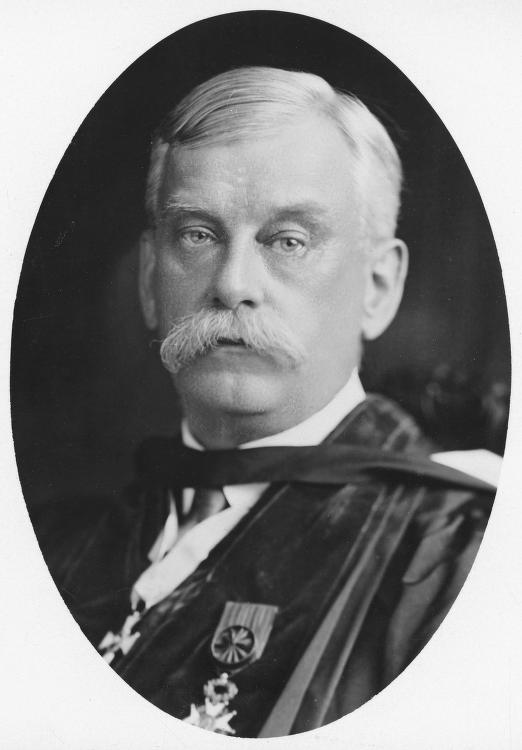|
Dahshur Boats
The Dahshur boats are a group of ancient Egyptian funeral boats, originally numbering five or six, discovered near the funerary complex of the 12th Dynasty pharaoh Senusret III. Excavation The boats were found during excavations on the plain of Dahshur in 1894 and 1895 by French archaeologist Jacques de Morgan. His original excavation report recorded six boats; however, later reports by de Morgan stated there were only five. The boats fell into obscurity until two of the boats were studied in the mid-1980s. As of 2022, the locations of only four of the boats are known; The Carnegie boat and the Chicago boat are in the United States, located in the Carnegie Museum of Natural History in Pittsburgh, and the Field Museum of Natural History in Chicago, respectively. The Red boat and the White boat were on display in the Cairo Museum, but were later relocated to the Sharm El-Sheikh Museum. Characteristics The boats are each about long and are constructed of cedar wood. They ... [...More Info...] [...Related Items...] OR: [Wikipedia] [Google] [Baidu] |
Dovetail Joint
A dovetail joint or simply dovetail is a joinery technique most commonly used in woodworking joinery (carpentry), including furniture, cabinets, log buildings, and traditional timber framing. Noted for its resistance to being pulled apart (tensile strength), the dovetail joint is commonly used to join the sides of a drawer to the front. A series of 'pins' cut to extend from the end of one board interlock with a series of 'tails' cut into the end of another board. The pins and tails have a trapezoidal shape. Once glued, a wooden dovetail joint requires no mechanical fasteners. History The dovetail joint technique probably pre-dates written history. Some of the earliest known examples of the dovetail joint are in ancient Egyptian furniture entombed with mummies dating from First Dynasty, the tombs of Chinese emperors, and a stone pillar at the Vazhappally Maha Siva Temple in India. The dovetail design is an important method of distinguishing various periods of furniture. The et ... [...More Info...] [...Related Items...] OR: [Wikipedia] [Google] [Baidu] |
Khufu Ship
The Khufu ship is an intact full-size solar barque from ancient Egypt. It was sealed into a pit at the foot of the Great Pyramid of pharaoh Khufu around 2500 BC, during the Fourth Dynasty of the ancient Egyptian Old Kingdom. Like other buried Ancient Egyptian ships, it was apparently part of the extensive grave goods intended for use in the afterlife. The Khufu ship is one of the oldest, largest and best-preserved vessels from antiquity. It is long and wide, and has been identified as the world's oldest intact ship, and described as "a masterpiece of woodcraft" that could sail today if put into a lake or a river. The ship was preserved in the Giza Solar boat museum, but was relocated to the Grand Egyptian Museum in August 2021. History Function The history and function of the ship is not precisely known. It is of the type known as a "solar barge", a ritual vessel believed by ancient Egyptians to carry the resurrected king across the heavens with the sun god Ra. However, ... [...More Info...] [...Related Items...] OR: [Wikipedia] [Google] [Baidu] |
Ancient Egyptian Technology
Ancient Egyptian technology describes devices and technologies invented or used in Ancient Egypt. The Egyptians invented and used many simple machines, such as the ramp and the lever, to aid construction processes. They used rope trusses to stiffen the beam of ships. Egyptian paper, made from papyrus, and pottery were mass-produced and exported throughout the Mediterranean Basin. The wheel was used for a number of purposes, but chariots only came into use after the Second Intermediate Period. The Egyptians also played an important role in developing Mediterranean maritime technology including ships and lighthouses. Technology in Dynastic Egypt Significant advances in ancient Egypt during the dynastic period include astronomy, mathematics, and medicine. Their geometry was a necessary outgrowth of surveying to preserve the layout and ownership of fertile farmland, which was flooded annually by the Nile River. The 3,4,5 right triangle and other rules of thumb served to r ... [...More Info...] [...Related Items...] OR: [Wikipedia] [Google] [Baidu] |
Abydos Boats
The Abydos boats are the remnants of a group of ancient royal Egyptian ceremonial boats found at an archaeological site in Abydos, Egypt. Discovered in 1991, excavation of the Abydos boats began in 2000 at which time fourteen boats were identified. They are located alongside the massive mudbrick structure known as Shunet El Zebib, attributed to the 2nd Dynasty Pharaoh Khasekhemwy. Shunet El Zebib is one of several such "enclosure wall" constructions at this site dating back to the 1st Dynasty, and is located nearly one mile from the early dynastic royal cemetery of Umm El Qa'ab. Discovery The University of Pennsylvania Museum and Yale University Expedition carried out the excavation of the Abydos boats. Lines of mudbrick uncovered by blowing sand were first noticed in 1988 at a site a mile away from the royal tombs in Abydos. These brick remains were first thought to be just walls. However, it was later determined that they were the boundaries for more than a dozen ship burials ... [...More Info...] [...Related Items...] OR: [Wikipedia] [Google] [Baidu] |
Associated Press
The Associated Press (AP) is an American non-profit news agency headquartered in New York City. Founded in 1846, it operates as a cooperative, unincorporated association. It produces news reports that are distributed to its members, U.S. newspapers and broadcasters. The AP has earned 56 Pulitzer Prizes, including 34 for photography, since the award was established in 1917. It is also known for publishing the widely used '' AP Stylebook''. By 2016, news collected by the AP was published and republished by more than 1,300 newspapers and broadcasters, English, Spanish, and Arabic. The AP operates 248 news bureaus in 99 countries. It also operates the AP Radio Network, which provides newscasts twice hourly for broadcast and satellite radio and television stations. Many newspapers and broadcasters outside the United States are AP subscribers, paying a fee to use AP material without being contributing members of the cooperative. As part of their cooperative agreement with the AP, most ... [...More Info...] [...Related Items...] OR: [Wikipedia] [Google] [Baidu] |
The Pittsburg Times
''The Pittsburg Times'' was a morning daily newspaper published in Pittsburgh, Pennsylvania, from 1880 to 1906. It was a predecessor of ''The Gazette Times'', which in turn was succeeded by the present-day ''Pittsburgh Post-Gazette''. History The ''Times'' began publication on 2 February 1880, with ''Pittsburgh Leader'' veteran Robert P. Nevin as founder, proprietor and editor. It was issued every morning except Sunday and was Republican Party (United States), Republican in politics. In 1884, Nevin sold out to a company headed by local political boss Christopher Magee (politician), Christopher Magee. The new publishers attracted subscribers by cutting the price of an issue from two cents to a penny, and by the end of the decade, reported a daily circulation exceeding that of the city's other morning papers. Having outgrown a series of modest quarters, the ''Times'' moved in 1892 to its new eight-story Times Building, designed by Frederick J. Osterling in Richardsonian Romanesqu ... [...More Info...] [...Related Items...] OR: [Wikipedia] [Google] [Baidu] |
William Jacob Holland
Rev William Jacob Holland FRSE LLD (August 16, 1848 – December 13, 1932) was the eighth Chancellor of the University of Pittsburgh (1891–1901) and Director of the Carnegie Museums of Pittsburgh. He was an accomplished zoologist and paleontologist, as well as an ordained Presbyterian minister. Life Holland was born August 16, 1848 in Jamaica, West Indies, the son of Rev Francis R Holland and his wife, Eliza Augusta Wolle. He spent his early years in Salem, North Carolina, later attending Nazareth Hall, a Moravian boys' school in Pennsylvania, followed by Amherst College, (A.B., 1869), and Princeton Theological Seminary (1874). At Amherst Holland's roommate was a student from Japan, causing Holland to become interested in Japanese and to learn that language well before it was a common pursuit in the United States. In 1874 he moved to Pittsburgh, Pennsylvania to become pastor of the Bellefield Presbyterian Church in the city's Oakland neighborhood. At this time Holland was also ... [...More Info...] [...Related Items...] OR: [Wikipedia] [Google] [Baidu] |
Andrew Carnegie
Andrew Carnegie (, ; November 25, 1835August 11, 1919) was a Scottish-American industrialist and philanthropist. Carnegie led the expansion of the American steel industry in the late 19th century and became one of the richest Americans in history. He became a leading philanthropist in the United States, Great Britain, and the British Empire. During the last 18 years of his life, he gave away around $350 million (roughly $ billion in ), almost 90 percent of his fortune, to charities, foundations and universities. His 1889 article proclaiming " The Gospel of Wealth" called on the rich to use their wealth to improve society, expressed support for progressive taxation and an estate tax, and stimulated a wave of philanthropy. Carnegie was born in Dunfermline, Scotland, and emigrated to Pittsburgh with his parents in 1848 at age 12. Carnegie started work as a telegrapher, and by the 1860s had investments in railroads, railroad sleeping cars, bridges, and oil derricks. H ... [...More Info...] [...Related Items...] OR: [Wikipedia] [Google] [Baidu] |
Nile
The Nile, , Bohairic , lg, Kiira , Nobiin language, Nobiin: Áman Dawū is a major north-flowing river in northeastern Africa. It flows into the Mediterranean Sea. The Nile is the longest river in Africa and has historically been considered the List of rivers by length, longest river in the world, though this has been contested by research suggesting that the Amazon River is slightly longer.Amazon Longer Than Nile River, Scientists Say Of the world's major rivers, the Nile is one of the smallest, as measured by annual flow in cubic metres of water. About long, its drainage basin covers eleven countries: the Democratic Republic of the Congo, Tanzania, Burundi, Rwanda, Uganda, Kenya, Ethiopia, Erit ... [...More Info...] [...Related Items...] OR: [Wikipedia] [Google] [Baidu] |
Wadi Gawasis
The Land of Punt (Egyptian: '' pwnt''; alternate Egyptological readings ''Pwene''(''t'') /pu:nt/) was an ancient kingdom known from Ancient Egyptian trade records. It produced and exported gold, aromatic resins, blackwood, ebony, ivory and wild animals.Shaw & Nicholson, p. 231. It is possible that it corresponds to Opone in Somalia, as later known by the ancient Greeks, while some biblical scholars have identified it with the biblical land of Put or Havilah. At times Punt is referred to as ''Ta netjer'' ('' tꜣ nṯr''), the "Land of the God". The exact location of Punt is debated by historians. Various locations have been offered, southeast of Egypt, a Red Sea coastal region: Somaliland, Somalia, Djibouti, northeast Ethiopia, Eritrea, and north-east Sudan. It is also possible that it covered both the Horn of Africa and Southern Arabia.Dimitri Meeks – Chapter 4 – "Locating Punt" from the book ''Mysterious Lands''", by David B. O'Connor and Stephen Quirke. Puntlan ... [...More Info...] [...Related Items...] OR: [Wikipedia] [Google] [Baidu] |





_1890s.jpg)


